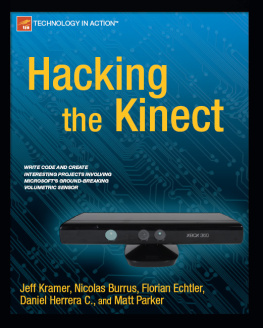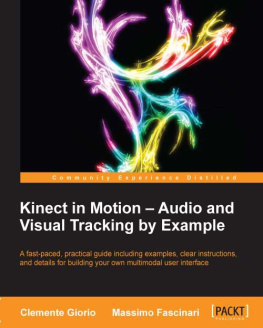Jeff Kramer - Hacking the Kinect
Here you can read online Jeff Kramer - Hacking the Kinect full text of the book (entire story) in english for free. Download pdf and epub, get meaning, cover and reviews about this ebook. year: 2012, publisher: Apress, genre: Computer. Description of the work, (preface) as well as reviews are available. Best literature library LitArk.com created for fans of good reading and offers a wide selection of genres:
Romance novel
Science fiction
Adventure
Detective
Science
History
Home and family
Prose
Art
Politics
Computer
Non-fiction
Religion
Business
Children
Humor
Choose a favorite category and find really read worthwhile books. Enjoy immersion in the world of imagination, feel the emotions of the characters or learn something new for yourself, make an fascinating discovery.
- Book:Hacking the Kinect
- Author:
- Publisher:Apress
- Genre:
- Year:2012
- Rating:5 / 5
- Favourites:Add to favourites
- Your mark:
Hacking the Kinect: summary, description and annotation
We offer to read an annotation, description, summary or preface (depends on what the author of the book "Hacking the Kinect" wrote himself). If you haven't found the necessary information about the book — write in the comments, we will try to find it.
Hacking the Kinect is the technogeeks guide to developing software and creating projects involving the groundbreaking volumetric sensor known as the Microsoft Kinect. Microsofts release of the Kinect in the fall of 2010 startled the technology world by providing a low-cost sensor that can detect and track body movement in three-dimensional space. The Kinect set new records for the fastest-selling gadget of all time. It has been adopted worldwide by hobbyists, robotics enthusiasts, artists, and even some entrepreneurs hoping to build business around the technology.
Hacking the Kinect introduces you to programming for the Kinect. Youll learn to set up a software environment, stream data from the Kinect, and write code to interpret that data. The progression of hands-on projects in the book leads you even deeper into an understanding of how the device functions and how you can apply it to create fun and educational projects. Who knows? You might even come up with a business idea.
- Provides an excellent source of fun and educational projects for a tech-savvy parent to pursue with a son or daughter
- Leads you progressively from making your very first connection to the Kinect through mastery of its full feature set
- Shows how to interpret the Kinect data stream in order to drive your own software and hardware applications, including robotics applications
- How to create a software environment and connect to the Kinect from your PC
- How to create three-dimensional images from the Kinect data stream
- How to recognize and work around hardware limitations
- How to build computer interfaces in the style of Minority Report
- How to interact directly with objects in the virtual world
- The ins and outs of point clouds, voxel occupancy maps, depth images, and other fundamentals of volumetric sensor technology
Hacking the Kinect is aimed at makers of all types. Tech-savvy artists can use the Kinect to drive three-dimensional, interactive artwork. Robotics hobbyists can create robots capable of seeing and responding to human motion and gesture. Programmers can create applications in which users manipulate data through physical motion and gestures. The creative possibilities are limitless, and fun!
Hacking the Kinect does require some programming background. Familiarity with programming in C++ or similar languages is assumed. Readers should also be reasonably comfortable working with electronicsfor example, with Arduino or similar equipment.
- Introducing the Kinect
- Hardware
- Software
- Computer Vision
- Gesture Recognition
- Voxelization
- Introducing Point Clouds
- Enhancing Our Point Clouds
- Object Modeling and Detection
- Multiple Kinects
Jeff Kramer: author's other books
Who wrote Hacking the Kinect? Find out the surname, the name of the author of the book and a list of all author's works by series.

















 Nicolas Burrus is a researcher in computer vision at the Carlos III University of Madrid, with a special interest in 3D object model acquisition and recognition for robotic applications. He actively took part in the impressive wave of interest that followed the release of the Kinect by publishing RGBDemo, an open source software showcasing many applications of the Kinect. RGBDemo is being used by many research labs, companies, and hobbyists, and this success led him to co-found the Manctl startup with the ambition of developing a low-cost universal 3D scanner. He holds a PhD from Paris VI University and a master's of computer science from EPITA (Paris, France).
Nicolas Burrus is a researcher in computer vision at the Carlos III University of Madrid, with a special interest in 3D object model acquisition and recognition for robotic applications. He actively took part in the impressive wave of interest that followed the release of the Kinect by publishing RGBDemo, an open source software showcasing many applications of the Kinect. RGBDemo is being used by many research labs, companies, and hobbyists, and this success led him to co-found the Manctl startup with the ambition of developing a low-cost universal 3D scanner. He holds a PhD from Paris VI University and a master's of computer science from EPITA (Paris, France).